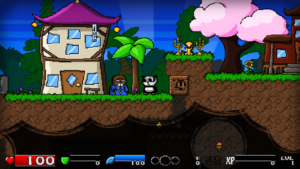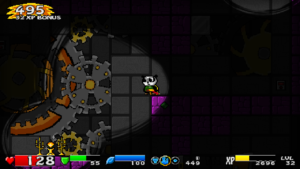Super Panda Adventures is a hack and slash platformer with an unusually open structure. Players take on the role of Fu, a panda who has recently finished his warrior training and must now save the princess from an invading army of robots. As you can probably tell from that description, this is a lighthearted and silly adventure across a world with an appropriately cartoonish hand-drawn aesthetic, but there is more to this game than the average hack and slash platformer.
Super Panda Adventures has two major strengths, the first of which is its combat customization options. Fu is very weak at the start of his quest and only possesses a sword and a shield and you’ll need to become very familiar with both of them. The sword can be swung rapidly by repeatedly pressing the attack button or you can hold the attack button down for a significantly stronger charged slash, though Fu loses movement speed while holding a charge. As to the shield it can be deployed at any time by holding the down key and learning to use it well can be very useful in combat, especially on the higher difficulties. Fu has a guard meter in addition to his health meter and part of this guard meter will go down whenever Fu is hit to reduce the damage to his health meter. However, if the shield is deployed when Fu is hit he loses a slightly larger chunk of his guard meter without any cost to his health and he gains more invincibility frames.

Alongside his sword and shield, Fu can gain access to a boomerang shuriken as well as three different spells and combining and upgrading these skills is a core part of the combat. Fu can gain experience and level up and every time he does he gains two points to spend across 16 skills. Each skill can be raised up to level ten and about half of these skills are ordinary yet useful passives, such as raising Fu’s maximum health or boosting the damage with a specific weapon or spell, while the other half are more unusual, such as a skill which created a damage shield around Fu whenever he catches his boomerang or one which gives Fu a chance to not lose any guard meter when he is hit while you have his shield up. Dozens of orbs are scattered around the game which can be used to further upgrade the damage on Fu’s sword and shuriken or grant him passive damage reduction by upgrading his armor, but all of his stat gains, including health increases, are tied to these 16 skills.
Though you will certainly want to use all of your abilities together, the skill system can greatly affect the way you play. If you want to stay at range, you can ignore the sword skills and focus on boosting the damage on the shuriken and the Mind Bullet spell while increasing mana and mana regeneration for nearly unlimited casting. Alternately, the sword is the only source of damage which can cause critical hits, so you can forsake increased range in favor of boosting the sword’s critical hit and life leech chances along with a few points in the stunning close-range explosive hammer spell. If you want to play more defensively, you can double Fu’s starting health and guard while raising the effectiveness of the shield and healing pickups. The one downside to this system is that the skill descriptions themselves are often overly vague; any skill which increases the chance for something to happen (ex: critical hit chance or a chance for Fu to gain an invincibility barrier for a few seconds after being hit) gives no indication of how much each point is actually boosting the chance by and skills which increase damage don’t indicate how much they actually increase it by. Despite not having any sort of class or equipment system in place, there’s enough variety between the skills to pull off any playstyle with a great sense of progression.

The experience system plays into increasing the sense of progression in Super Panda Adventures. You do not directly gain experience from killing enemies. Instead, Fu can collect three tiers of experience items scattered around each area and he can gain additional experience based on how much damage he has dealt in a single attack chain. As a result, in the early parts of the game where Fu does not have all of his combat skills available to him and enemies die quickly you rely almost entire upon finding the experience items. However, as the game goes on and Fu begins to take on larger groups of stronger enemies and gains more ways to damage enemies from afar so as not to drop the chain you gradually shift over to gaining most of your experience from fighting enemies.
I mentioned that the combat customization was one of this game’s two main strengths and the other one is its nonlinear progression. The game is divided into several different areas spread across a world map. The ultimate goal may be to rescue the princess from robots, but you immediately start to encounter various side quests along the way. Most of these quests grant abilities which are mandatory for finishing the game, such as being able to use arrow markers to gain an upward boost in the air, yet the order in which you do them is largely up to you. Only on rare occasions are your options for progression limited to a single choice and you often have three or more potential places to go to. Quest chains can lead to unlocking entirely new areas to visit and at times you might go to an area for one quest only to find an entirely new one waiting there for you. Though they exist, roadblocks in the main quest related to specific abilities are few and far between and the beginning points for new quests are often near the objectives of quests you already have. Add in some helpful arrows on the world map which point out all the areas with new quests and objectives for current quests and not only is there rarely a point where you feel locked in to a single quest, but you also never need to worry about being confused as to just where to go.

Quests aren’t the only worthwhile thing about this game’s progression. Every area in the game has three colored keys to find which open corresponding doors. Sometimes, the sole purpose of a key is to gain access to a quest item or even just another key, but keys can also be used to gain access to large chunks of an area, rooms brimming with experience items, or some of the valuable orbs needed for upgrading Fu’s weapons and armor. Not every item is locked behind a door, but many of the keys can only be obtained with abilities found well after gaining access to their respective areas so simply popping into an area and checking if you already have all three keys is a great way to easily tell if there are still secrets to be found. Individual areas themselves are generally nonlinear with dark caves to explore and mountains to climb and more often than not the starting point is near the center of the map with places to explore in either direction. Over half a dozen powerful relics are also scattered around the game’s world and they are by far the most difficult items to find and obtain. Each relic is split into two pieces and you can only gain their benefit if you find both halves. Though relics cannot be upgraded and are not necessary for finishing the game, they give extremely powerful benefits, such as gradually restoring Fu’s health if it falls under 50% and doubling the amount of experience earned from damage chains in combat. Between quests, equipment upgrades, leveling up, finding relics, and unlocking new areas, Super Panda Adventures is fantastic when it comes to providing a steady flow of meaningful progression.

For all of its good points, this game does have one significant downside – it overstays its welcome and the final third of the game begins to noticeably drag. In theory this final stretch should be one of the most exciting parts because it introduces an entirely new region and immediately gives you access to one of the most useful abilities in the game. Unfortunately, this is also the point where the game loses a large chunk of its nonlinearity. By the time you reach this segment you will have very likely finished up all or most of your quests and, other than the main quest, only two new quests are introduced here, both of which are short and take place in the same areas in the same order as each other. Most of the areas here are themselves much more linear than previous areas and fairly short with their designs geared towards making your way to quest objectives with a handful of collectibles sprinkled along the way. A few new environmental obstacles get added into the mix here in the form of moving platforms and conveyor belts, but the platforming in Super Panda Adventures is generally extremely easy, most of the difficulty comes from the combat, and these changes don’t add much in the way of excitement to make up for the reduction in freeform exploration. Combine all this with the fact that, not including a couple of bosses, only a single new enemy gets added to the roster of mechanical menaces for this entire portion and the end result is a finale which feels like it’s constantly trying to wrap things up while continuing to drag on.
Even though it loses its balance near the end, Super Panda Adventures is overall an ambitious, charming, and surprisingly unique game with far more polish and care put into it than I ever expected of something with such a silly name.